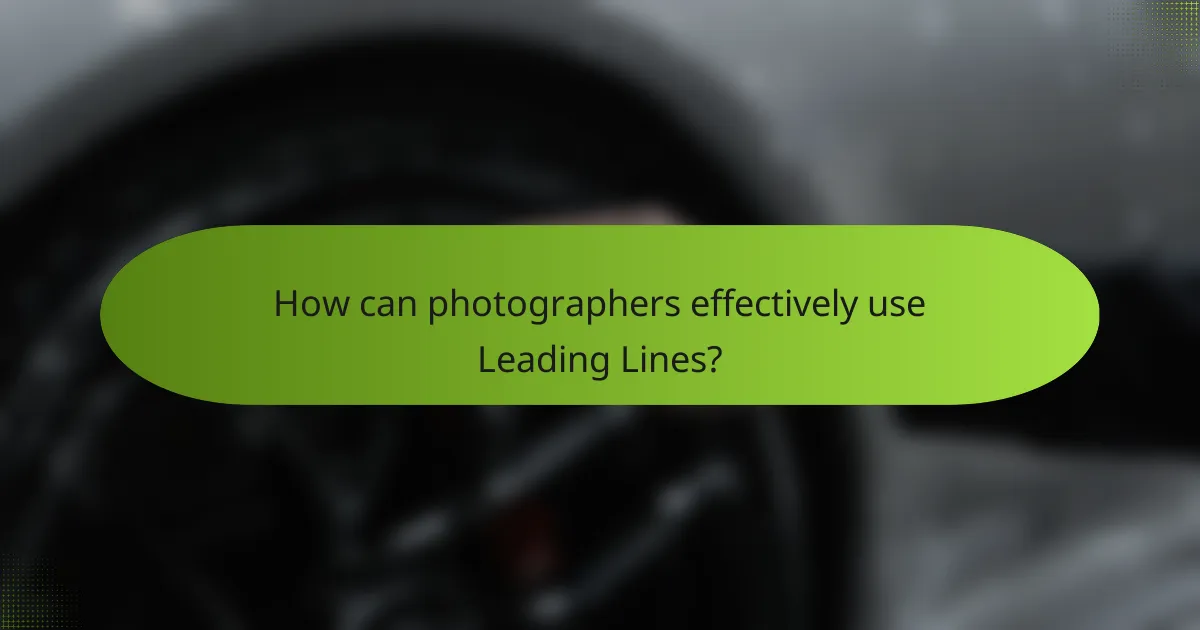
What are Leading Lines in Photography?
Leading lines in photography are compositional elements that guide the viewer’s eye through an image. They can be natural or man-made lines that create a sense of depth and perspective. Common examples include roads, rivers, fences, and architectural features. Leading lines help to draw attention to the main subject of a photograph. They can create a visual path that enhances storytelling. The use of leading lines can make an image more dynamic and engaging. Photographers often use them to lead the viewer toward a focal point. This technique is widely recognized in visual arts for its effectiveness in composition.
How do Leading Lines contribute to visual storytelling?
Leading lines guide the viewer’s eye through an image, enhancing visual storytelling. They create a sense of depth and perspective. By directing attention to focal points, they help convey a narrative. For example, roads or paths can symbolize a journey. This technique is widely used in photography to evoke emotions. Studies show that images with leading lines are more engaging. They can also establish a mood or theme within the composition. Overall, leading lines are essential for effective visual communication.
What types of Leading Lines are commonly used in photography?
Common types of leading lines in photography include straight lines, curved lines, diagonal lines, and converging lines. Straight lines often guide the viewer’s eye directly to the subject. Curved lines create a sense of movement and flow within the composition. Diagonal lines add dynamism and tension, enhancing visual interest. Converging lines draw attention to a focal point, creating depth in the image. These techniques are widely recognized for their ability to enhance visual storytelling in photography.
How do different types of Leading Lines affect composition?
Leading lines are compositional elements that guide the viewer’s eye through a photograph. Different types of leading lines, such as straight, curved, and diagonal lines, create distinct visual effects. Straight lines often convey stability and order, while curved lines introduce a sense of movement and flow. Diagonal lines can create tension and dynamism, enhancing the energy of the composition.
The placement and direction of these lines significantly impact the viewer’s perception. For instance, lines leading to a focal point can draw attention and create a sense of depth. Lines that converge can evoke a feeling of perspective and distance. Research in visual perception indicates that leading lines can enhance the viewer’s engagement with the image.
In summary, the type of leading line used in a composition directly influences the overall visual narrative and emotional response elicited from the viewer.
Why are Leading Lines important for photographers?
Leading lines are important for photographers because they guide the viewer’s eye through an image. They create depth and perspective, making a composition more engaging. Leading lines can emphasize a subject or draw attention to specific areas of a photograph. They also help establish a sense of direction and movement. According to a study by the American Society of Media Photographers, images with leading lines are perceived as more dynamic. This technique enhances visual storytelling by creating a narrative flow. Photographers often use roads, rivers, or architectural elements as leading lines. These elements can transform a flat image into a compelling visual experience.
What emotional responses can Leading Lines evoke in viewers?
Leading lines can evoke a range of emotional responses in viewers. These lines guide the viewer’s eye and create a sense of movement. They can instill feelings of curiosity as viewers follow the path suggested by the lines. Leading lines often convey depth, which can evoke feelings of tranquility and calmness. Additionally, they can create tension or drama, depending on their direction and context. For instance, lines that converge can suggest urgency or conflict. Research indicates that compositions using leading lines enhance engagement by directing focus. This technique is utilized in various photography styles to elicit specific emotions effectively.
How can Leading Lines guide the viewer’s eye through an image?
Leading lines guide the viewer’s eye through an image by creating a visual pathway. These lines draw attention and direct focus to the main subject. They can be natural elements like roads or rivers. They can also be man-made structures like fences or railings. The use of leading lines enhances composition and depth. This technique helps establish a sense of perspective. Studies show that images with leading lines are more engaging. They encourage the viewer to explore the entire frame.

How can photographers effectively use Leading Lines?
Photographers can effectively use leading lines by incorporating natural or architectural elements that draw the viewer’s eye toward the subject. These lines can be roads, rivers, fences, or any linear features in a scene. They create a sense of depth and perspective in the composition. By positioning the lines to lead towards the main subject, photographers can enhance focus and engagement.
Using leading lines also helps to guide the viewer’s journey through the photograph. This technique is widely recognized in photography for its ability to create dynamic compositions. Research shows that images with strong leading lines are more visually appealing and can evoke emotion. Effective use of leading lines can significantly improve the storytelling aspect of photography.
What techniques enhance the use of Leading Lines in photography?
Techniques to enhance the use of leading lines in photography include utilizing natural elements, applying compositional rules, and experimenting with perspective. Natural elements like roads, rivers, or fences can serve as effective leading lines. Compositional rules such as the rule of thirds can help position these lines strategically within the frame. Additionally, changing the perspective by shooting from a low angle or high vantage point can create more dynamic leading lines. Using curves rather than straight lines can also add interest and guide the viewer’s eye more effectively. These techniques help to create depth and draw attention to the main subject, enhancing the overall visual storytelling in photography.
How can photographers identify potential Leading Lines in a scene?
Photographers can identify potential leading lines in a scene by observing the natural and man-made elements that guide the viewer’s eye. They should look for roads, pathways, fences, or any linear features that draw attention. Strong leading lines often converge towards a focal point, enhancing composition. Photographers can also utilize shapes and patterns in the environment, such as the edges of buildings or the curves of rivers. High vantage points may provide a better overview of potential lines. Moreover, adjusting the camera angle can reveal hidden lines that may not be immediately visible. This technique is widely recognized in photography as a way to create depth and perspective.
What role does perspective play in emphasizing Leading Lines?
Perspective is crucial in emphasizing leading lines in photography. It determines how lines are perceived within the frame. A low angle can make lines appear more dramatic and pronounced. Conversely, a high angle can flatten the composition, diminishing their impact. The viewer’s position influences the direction and convergence of lines. This manipulation guides the viewer’s eye toward focal points. Effective use of perspective enhances depth and dimension in the image. By altering perspective, photographers can create a stronger narrative through leading lines.
What common mistakes should photographers avoid with Leading Lines?
Photographers should avoid placing leading lines in the center of the frame. Centered lines can lead to a static composition. Instead, lines should be positioned to guide the viewer’s eye through the image. Ignoring the background can also be a mistake. A cluttered background can distract from the leading lines. Photographers should ensure that the background complements the lines. Overusing leading lines can make images feel forced. A balanced approach enhances visual storytelling. Lastly, not considering the angle of the lines can diminish their impact. Lines should create a sense of depth and perspective.
How can misusing Leading Lines detract from a photograph’s impact?
Misusing leading lines can significantly detract from a photograph’s impact. When leading lines are poorly aligned, they can confuse the viewer’s eye. This misalignment can lead to a lack of focus on the main subject. Additionally, leading lines that draw attention away from the subject can create visual distractions. For instance, lines that lead out of the frame can leave viewers feeling unsettled. A photograph may also feel unbalanced if the leading lines do not guide the viewer effectively. In essence, improper use of leading lines can undermine the intended narrative of the image. This is supported by studies showing that effective composition enhances viewer engagement.
What are some examples of poorly executed Leading Lines?
Poorly executed leading lines can detract from a photograph’s composition. One example is when leading lines lead away from the main subject. This can create confusion about the focal point. Another example is using leading lines that are too subtle or weak. These lines may fail to guide the viewer’s eye effectively. Additionally, leading lines that are obstructed or interrupted can disrupt visual flow. For instance, a line that is broken by an unwanted object can confuse the viewer. Lastly, using leading lines that are not relevant to the subject can dilute the image’s impact. This can happen when lines are included that do not connect to the narrative.

What practical tips can improve the use of Leading Lines?
To improve the use of leading lines in photography, consider these practical tips. First, identify natural lines in your environment. Roads, fences, and rivers often create strong leading lines. Second, position your camera at an angle that emphasizes these lines. This can draw the viewer’s eye toward the main subject. Third, use perspective to enhance depth. Lines that converge can create a sense of three-dimensional space. Fourth, incorporate foreground elements. This can add context and strengthen the leading line effect. Fifth, experiment with different compositions. Sometimes, a slight change in angle can significantly impact the leading lines. Lastly, practice with post-processing techniques. Adjusting contrast and clarity can make leading lines more prominent. These tips can enhance visual storytelling by guiding the viewer’s attention effectively.
How can photographers practice incorporating Leading Lines into their work?
Photographers can practice incorporating leading lines by actively seeking out natural lines in their environment. They should explore different locations, such as parks, streets, and buildings. Using a camera, they can frame their shots to include these lines. For example, roads, fences, or pathways can guide the viewer’s eye. Photographers should experiment with angles to emphasize the leading lines. They can also adjust their composition to create depth and perspective. Reviewing their images afterward helps them understand the effectiveness of leading lines. This practice enhances their ability to tell visual stories through photography.
What exercises can help develop an eye for Leading Lines?
To develop an eye for leading lines, practice exercises that emphasize their identification and composition. One effective exercise is to walk in various environments and consciously look for natural and man-made lines. This includes roads, pathways, fences, and shadows. Another useful exercise is to create compositions using leading lines in photography. Frame subjects by aligning them with these lines to guide the viewer’s eye. Additionally, sketching scenes that incorporate leading lines can enhance visualization skills. Studies show that actively seeking out and utilizing leading lines improves compositional skills in photography.
How can post-processing enhance Leading Lines in photographs?
Post-processing can enhance leading lines in photographs by adjusting contrast and brightness. Increased contrast makes leading lines more prominent, guiding the viewer’s eye effectively. Brightness adjustments can highlight these lines, ensuring they stand out against the background. Additionally, sharpening can enhance the clarity of leading lines, making them more defined. Cropping can also help focus on the leading lines, eliminating distractions. Color correction can create a more cohesive look, emphasizing the lines’ impact. These techniques collectively improve the visual storytelling aspect of the photograph.
What resources are available for learning more about Leading Lines?
Books, online courses, and photography blogs are available for learning about leading lines. Notable books include “The Photographer’s Eye” by Michael Freeman, which discusses composition techniques. Online platforms like Udemy and Skillshare offer courses specifically focused on photography composition, including leading lines. Popular photography blogs such as Fstoppers and PetaPixel frequently publish articles on composition techniques. Additionally, YouTube channels dedicated to photography provide visual demonstrations of leading lines in practice. These resources collectively enhance understanding of how leading lines contribute to effective visual storytelling in photography.
Which books or online courses focus on visual storytelling techniques?
Books that focus on visual storytelling techniques include “Understanding Comics” by Scott McCloud and “The Visual Story” by Bruce Block. Online courses such as “Visual Storytelling: Crafting Your Story” on platforms like Skillshare and “The Art of Visual Storytelling” on Udemy also cover these techniques. These resources provide insights into the principles and practices of effective visual narratives. They are well-regarded in the field of visual communication and storytelling.
How can photographers find inspiration from others using Leading Lines?
Photographers can find inspiration from others using leading lines by analyzing compositions in existing works. Leading lines guide the viewer’s eye and create depth in an image. By studying photos from various genres, photographers can observe how lines direct focus and create movement. Notable photographers often use leading lines effectively, making their work a valuable resource. Examining these images helps identify different techniques and contexts for using leading lines. Additionally, photographers can experiment by incorporating similar lines in their own shoots. This practice enhances their understanding of composition and visual storytelling.
The main entity of the article is ‘leading lines’ in photography, which are compositional elements that guide the viewer’s eye through an image. The article explores how leading lines enhance visual storytelling by creating depth, perspective, and directing attention to focal points. It discusses common types of leading lines, their impact on composition, and techniques for effective use, as well as the emotional responses they can evoke in viewers. Additionally, the article provides practical tips for photographers to identify and utilize leading lines, along with resources for further learning on visual storytelling techniques.
